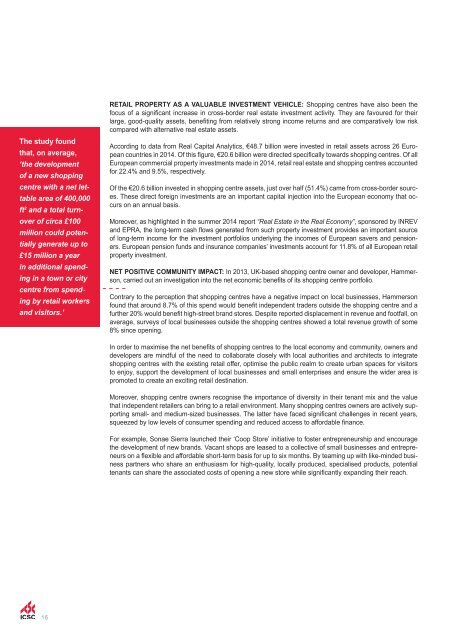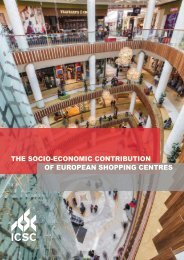THE SOCIO-ECONOMIC CONTRIBUTION OF EUROPEAN SHOPPING CENTRES
Create successful ePaper yourself
Turn your PDF publications into a flip-book with our unique Google optimized e-Paper software.
The study found<br />
that, on average,<br />
‘the development<br />
of a new shopping<br />
centre with a net lettable<br />
area of 400,000<br />
ft 2 and a total turnover<br />
of circa £100<br />
million could potentially<br />
generate up to<br />
£15 million a year<br />
in additional spending<br />
in a town or city<br />
centre from spending<br />
by retail workers<br />
and visitors.’<br />
RETAIL PROPERTY AS A VALUABLE INVESTMENT VEHICLE: Shopping centres have also been the<br />
focus of a significant increase in cross-border real estate investment activity. They are favoured for their<br />
large, good-quality assets, benefiting from relatively strong income returns and are comparatively low risk<br />
compared with alternative real estate assets.<br />
According to data from Real Capital Analytics, €48.7 billion were invested in retail assets across 26 European<br />
countries in 2014. Of this figure, €20.6 billion were directed specifically towards shopping centres. Of all<br />
European commercial property investments made in 2014, retail real estate and shopping centres accounted<br />
for 22.4% and 9.5%, respectively.<br />
Of the €20.6 billion invested in shopping centre assets, just over half (51.4%) came from cross-border sources.<br />
These direct foreign investments are an important capital injection into the European economy that occurs<br />
on an annual basis.<br />
Moreover, as highlighted in the summer 2014 report “Real Estate in the Real Economy”, sponsored by INREV<br />
and EPRA, the long-term cash flows generated from such property investment provides an important source<br />
of long-term income for the investment portfolios underlying the incomes of European savers and pensioners.<br />
European pension funds and insurance companies’ investments account for 11.8% of all European retail<br />
property investment.<br />
NET POSITIVE COMMUNITY IMPACT: In 2013, UK-based shopping centre owner and developer, Hammerson,<br />
carried out an investigation into the net economic benefits of its shopping centre portfolio.<br />
Contrary to the perception that shopping centres have a negative impact on local businesses, Hammerson<br />
found that around 8.7% of this spend would benefit independent traders outside the shopping centre and a<br />
further 20% would benefit high-street brand stores. Despite reported displacement in revenue and footfall, on<br />
average, surveys of local businesses outside the shopping centres showed a total revenue growth of some<br />
8% since opening.<br />
In order to maximise the net benefits of shopping centres to the local economy and community, owners and<br />
developers are mindful of the need to collaborate closely with local authorities and architects to integrate<br />
shopping centres with the existing retail offer, optimise the public realm to create urban spaces for visitors<br />
to enjoy, support the development of local businesses and small enterprises and ensure the wider area is<br />
promoted to create an exciting retail destination.<br />
Moreover, shopping centre owners recognise the importance of diversity in their tenant mix and the value<br />
that independent retailers can bring to a retail environment. Many shopping centres owners are actively supporting<br />
small- and medium-sized businesses. The latter have faced significant challenges in recent years,<br />
squeezed by low levels of consumer spending and reduced access to affordable finance.<br />
For example, Sonae Sierra launched their ‘Coop Store’ initiative to foster entrepreneurship and encourage<br />
the development of new brands. Vacant shops are leased to a collective of small businesses and entrepreneurs<br />
on a flexible and affordable short-term basis for up to six months. By teaming up with like-minded business<br />
partners who share an enthusiasm for high-quality, locally produced, specialised products, potential<br />
tenants can share the associated costs of opening a new store while significantly expanding their reach.<br />
16



